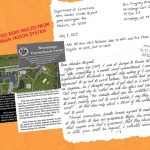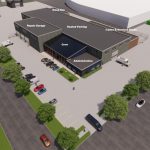Present Music Roams with the Buffalo

A pile of bison skulls to be processed, in Detroit c. 1870. Detroit Public Library photo, public domain via Wikipedia Commons.
At least 25 million and as many as 125 million buffalo roamed the 48 states as late as 1850. By 1890, fewer than 500 remained.
In 1990, composer Jerome Kitzke surveyed the empty plains at Wounded Knee, South Dakota. He imagined them covered with thousands of grazing buffalo. He began to think about the musical and theatrical possibilities of the animals he’d seen in his mind. Years later, that vision led to a composition and a Present Music commission — set in motion at artistic director Kevin Stalheim’s New Year’s Eve party in 2006. This weekend, Present Music will premiere Kitzke’s Buffalo Nation.
It will be the third Kitzke/Present Music piece that touches on Native American life, after Box Death Hollow (1990) and Paha Sapa Give-Back (1993). Kitzke had been in South Dakota researching those pieces; in 1988, he met Charlotte Black Elk, a Lakota Sioux who also contributed to Buffalo Nation. It fits that the first two performances will occur in the Drum Room of the Indian Community School, in Franklin. On Sunday, the whole production will move to the auditorium of the MPS Lincoln Center for the Arts.
And Buffalo Nation is a production. It involves 14 instruments (including accordion, piano, Hammond organ and a large percussion battery), a sound effects chorus of 28 (one chorister for each rib in a bison), four actors, a baritone soloist (Kurt Ollmann), projected animations (by Stacey Steers) and photographs, and spoken, chanted and sung text by librettist Kathleen Masterson. The score runs 545 pages. The piece runs about 75 minutes.
“The chorus starting calling themselves ‘the Buffalo Herd,’ and that’s what we’re calling them now,” Kitzke said, in a joint interview with Masterson Wednesday afternoon. “The chorus only sings 12 bars in the whole piece. The rest of it is wind sounds, the snorting and stomping of bison, the sounds of wolves and coyotes. They chant ha, he and ho, to define rhythms. And each of them has two stones. They hit them together, to describe the hunt. They mimic gunshots.”
The historical bison slaughter was not accidental. Kitzke and Masterson, who have studied the animal extensively, said that white hunters systematically destroyed the herds for reasons of warfare against the Indian tribes who were dependent upon them and, increasingly, for economic reasons. An industry grew up around the processing of their hides, meat and even bones, which were valued for their industrial uses.
“You’d expect to find bison bones everywhere,” Kitzke said. “But I’ve been all over the west, and you can’t find them anywhere. They were collected and used in bone china and in sugar refining. The bison trade was very lucrative after the Civil War.”
For a while. As the resource dwindled, industry found alternatives and the price crashed.
“What kind of a country were we becoming as we did this?” Masterson asked. “The West changed from an economy of kinship and subsistence to one based on competition, and we ended up with genocide. The animal was a way of life for hundreds of thousands of people, and it was eliminated.”
The destruction gave Kitzke a hint of a musical form, and every composer needs an armature — a skeleton, perhaps — to build around. Seven closely related Rondos are among the 13 sections. Composer and librettist refer to the intervening parts as songs, primarily for baritone Kurt Ollmann. Everyone plays the first Rondo. Participation dwindles from there, and the Rondos become successively shorter. Until the last one. Bison numbers are rising; conservation efforts began in the 1890s and have gained ground ever since. The music reflects that.
“In the late 19th century, hunters and sportsmen and Indians thought the buffalo should be saved,” Masterson said. “Field & Stream magazine became a big advocate. A rancher, Charles Goodnight, found a herd on a vast cattle spread he owned, and his wife advocated for preserving it. The fourth section of the piece, ‘Praise Song,’ is a chant to the Buffalo Savers.”
Masterson grew up in Virginia, and Kitzke is a Milwaukee native. They both have lived in New York for many years. Masterson, who has worked with a number of composers in her career, and Kitzke kicked around Buffalo ideas for quite some time but were making little progress. The galvanizing moment came during a trip to Pine Ridge, South Dakota, in June of 2010, to visit with Charlotte Black Elk.
“She was a character in the piece, called Claire,” Masterson said. “But I didn’t want to put words in her mouth. So we interviewed her about bison.”
“Charlotte is such an articulate speaker,” Kitzke said. “We could pretty much just use her words. We stage it like an interview in the piece.”
The Sioux maintain buffalo herds on some of their South Dakota lands. These animals have always meant a lot to these people, but they aren’t pets. The libretto includes this recipe, from Charlotte Black Elk:
Take a slab of buffalo hump,
Cut it like a pillowcase,
Carefully turn it inside out,
Take your time.
Pack it with onions,
An apple,
Garlic,
And dried corn.
Sew it shut.
Bake it,
Low heat,
Not too long.
This will seal the juices in
But will not change the flavor
Of the meat.
Grind fresh pepper
Over the top.
Inhale.
Take your time.
Concert Information: 4:30 and 7:30 p.m. Saturday, April 14, at Indian Community School, 10405 W. St. Martins Rd., Franklin; and 4 p.m. Sunday, April 15, at Lincoln Center for the Arts, 820 E. Knapp St., Milwaukee. Kitzke and Masterson will host pre- and post-concert talks Saturday, at 3:45 p.m. and 8:45 p.m. Tickets are $35, $25 or $15, and student tickets are half-price. Call (414) 271-0711 or visit the Present Music website to order.
Credits (in addition to those mentioned above): Actors – Alison Mary Forbes, Joel Kopischke, Norman Moses, Lisa Golda; director – Jim Butchart; Buffalo Herd director – Bonnie Scholz; Musicians – Linda Edelstein, oboe and english horn; William Helmers, clarinet and bass clarinet; Don Sipe, trumpet; Eric Segnitz, violin, banjo; Adrien Zitoun, cello; Collins Trier, bass; Stas Venglevski, accordion; Wil Smith, Hammond organ; Ruben Piirainen, piano; Terry Smirl, percussion.
A complete list of credits for all visuals and Masterson citations, along with program notes and the song lyrics, can be downloaded from this page at Present Music’s website.
























Sounds fascinating. Any chance you can bring this to the Madison area?